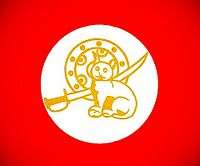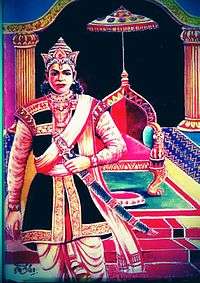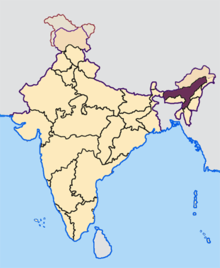Sutiya Kingdom
| Sutiya Kingdom Sadiya | ||||||||||
| চুতীয়া ৰাজ্য (Assamese) | ||||||||||
| ||||||||||
|
| ||||||||||
| Capital | Swarnagiri (1187-1225) Ratnapur (present-day Majuli) (1225-1248) Sadiya (1248-1524) | |||||||||
| Languages | Assamese | |||||||||
| Religion | Hinduism, Shaktism[1] | |||||||||
| Government | Monarchy | |||||||||
| Monarch | ||||||||||
| • | 1187 - 1210 | Birpal (first) | ||||||||
| • | 1522 - 1524 | Nityapal (last) | ||||||||
| Historical era | Medieval Assam | |||||||||
| • | Founded by Birpal |
1187 | ||||||||
| • | Expansion under Gaurinarayan | 1210 -1250 | ||||||||
| • | Ahom-Sutiya war | 1513 -17th century | ||||||||
| • | Siege of Sadiya | 17 April 1524 | ||||||||
| • | Disestablished | 1673 | ||||||||
| ||||||||||
| Today part of | India | |||||||||
| Sutiya dynasty | |
|---|---|
|
Part of History of Assam  | |
| Kings of Sutiya kingdom (1187 - 1524) | |
| Birpal | 1187- 1210 |
| Ratnadhwajpal | 1210- 1250 |
| Vijayadhwajpal | 1250- 1270 |
| Vikramadhwajpal | 1270- 1285 |
| Gauradhwajpal | 1285- 1305 |
| Sankhadhwajpal | 1305- 1325 |
| Mayuradhwajpal | 1325- 1343 |
| Jayadhwajpal | 1343- 1360 |
| Karmadhwajpal | 1360- 1380 |
| Satyanarayan | 1380- 1400 |
| Laksminarayan | 1400- 1420 |
| Dharmanarayan | 1420- 1445 |
| Pratyashnarayan | 1445- 1465 |
| Yasnarayan | 1465- 1480 |
| Purnadhabnarayan | 1480- 1500 |
| Dharmadhajpal | 1500- 1522 |
| Nityapal | 1522- 1524 |
| Sutiya monarchy data | |
|
Swarnagiri Ratnapur Sadiya (Capitals of the kingdom) | |
| Peacock Flag (Royal Flag) | |
| Golden cat and sword (Coats of arms) | |
| Sutiya Buranji (Chronicle) | |
The Sutiya Kingdom(Gait 1906:38–40) or Sadiya (Assamese: চুতীয়া ৰাজ্য) (1187-1673) was a state established by Birpal in 1187 in the areas comprising the present Indian states of Assam and Arunachal Pradesh. The kingdom absorbed the ancient Pal dynasty of Kamarupa and reigned for over 400 years in eastern Assam and Arunachal Pradesh with its capital at Sadiya.[2] It became the dominant power in eastern Assam in the 12th century and remained so until the 16th century with its domain from Parshuram Kund in the east to Vishwanath[3] in the west and in the process of its expansion had absorbed many local communities and tribes.
It controlled the present Assam districts of Lakhimpur, Dhemaji, Tinsukia, parts of Jorhat, Dibrugarh, Sonitpur and East Siang, Subansiri, Lower Dibang, Lohit districts of Arunachal Pradesh.[4] The Sutiya are an ethnic group originally from Tibet and the Sichuan province of China.
Most illustrious of the Sutiya kings was Gaurinarayan (Ratnadhwajpal)[5] son of Birpal. He brought many other Sutiya groups into his kingdom. In 1224 Ratnadhwajpal defeated Bhadrasena, the king of Swetagiri. Then he went on to subjugate Nyayapal and marched toward Kamatapur, where he formed an alliance with the Kamata ruler by marrying a princess. Then he marched to Dhaka, and made friends with the Gauda ruler. The hostilities with the Ahoms began when the Sutiya Kingdom expanded to the south and during which Ahom king, Sutuphaa, was killed by the Sutiya king during a friendly negotiation. This conflict triggered a number of battles between the two sides, which saw great loss of men and money. The simmering dispute often flared till 1524 when the Ahoms struck the Sutiya Kingdom at its weakest state, took Sadiya and killed the then king Nityapal. The Ahoms established their rule by instituting the position of Sadiyakhowa Gohain, a newly constituted position of frontier-governor in charge of Sadiya. But the Sutiya had dispersed to frontier regions, and continued raids against the Ahoms. It finally ended in 1673 when they fall under the domination of the Ahoms.
Etymology
According to Sutiya language, the word Sutiya stands for glory.
History

Background
Assamese chronicles name Asambhinna (6th -7th century) as the first Sutiya king, who dwelt on the banks of Brahmaputra with his seven brothers. In his reign came a Brahmin, who converted all the seven brothers into Hinduism and married Asambhina's daughter. On the King's death, his seven brothers failing to agree on a successor, put the Brahmin on the throne as a vassal, who in turn was followed by a descendent of Asambhinna, called Indra Dev Raja and the latter ruled for 30 years. Thereafter, 31 kings followed Indra Dev Raja in regular succession, the last being Lekroy Raja who had four sons: Burora, Maisura, Kolaito and Kossi.
On the death of Lekroy and before the succession issue could be decided, Sambhun pha the Mau king invaded the country and consequently:(1) Burora was killed in the battlefield;(2) Maisura fled with his followers to Maing Bing ( near present Biswanath);(3) Kolaito fled westward with a considerable force and formed a kingdom on the banks of Brahmaputra;(4) Kossi Raja was captured and placed as a vassal. Sambhung pha then appointed a Tamon (Governor) over the vassal kingdom and returned to Mogaung. Four months later, Tamon was poisoned to death and Kossi Raja became independent.
Thus, 31 rulers intervened between Indra Dev Raja and Kossi Raja over an aggregate of 554 years. So the accession of Asambhinna can roughly be placed in the middle of the 7th century.[6]
Foundation
The founder of the kingdom was Birpal who claimed descent from the legendary Bhishmak and reigned in 1187. He ruled over 60 families with his capital on a hill called Swarnagiri and assumed the title of Gayapal. The surname 'Pal' is possible imitation of the Pala dynasty of Kamarupa. He was succeeded by his son Sonagiri assuming the title of Gaurinarayan. [7]
Expansion under Gaurinarayan (1224-1250)

Gaurinarayan alias Ratnadhwajpal was one of the most powerful Sutiya king, he brought under his sway tribes of neighbouring mountains Rangalgiri, Kalgiri, Nilgiri, Chandragiri, Dhavalgiri etc. He conquered the whole northeastern region of Assam which included the areas of present-day Arunachal Pradesh and assumed the proud title of Lord of Hills. In the year 1224, with a large army, he descended on the valley of Brahmaputra, attacked and deported a king named Bhadrasena, ruler of Swetagiri Mountains. In the expedition, he gained rich booty and many prisoners of war belonging to Brahmin, Tanti, Sonari, Sutar and Kumar castes and settled them in various parts of the kingdom. He built his capital at Ratnapur, hence also called Ratnadhwajpal and used certain techniques to advance the agricultural system in the kingdom. The neighbouring king, Nyaya Pal surrendered with costly gifts, even before he was attacked. To cement the alliance, he married the daughter of Nyayapal. He build a line of forts along the foot of the bills against inroads by the hill tribes and build large tanks and temples for his people. In Kamatapur, when Kamateswar refused his daughter for one of Gaurinarayan sons, the king marched against him, constructing a road with forts at certain intervals. Alarmed at the energy displayed by his troops, Kamateswar agreed to give one of the Princess in marriage to the Sutiya Prince.[8]
These expeditions by Gaurinarayan took Sutiya Kingdom to supremacy to such an extent that after a few years the impact of his power was felt even by the Gauda ruler. The Gauda ruler possibly Khesav Sen made friends with Gaurinarayan who sent one of his son to that country for education. Unfortunately, the Sutiya Prince died there and the corpse was sent to Gaurinarayan, who was then engaged in building a new city. He named the city as Sadiya (Sa-Corpse, Diya-Given) which later on became the capital of the Sutiya Kingdom. Extensive remains of buildings and fortifications built during the rule of the Sutiyas near about Sadiya still point to the importance of the region in the past.
During the reign of Ahom king Sutuphaa, there were frequent skirmishes between Ahoms and Sutiyas. In 1376, Sutuphaa was killed by the Sutiya King evidently Jayadhwajpal during a friendly encounter. During the following years, both the sides got involved in numerous battles.
Ahom-Sutiya conflicts (1513-1522)
Dhirnarayan alias Dharmadhwajpal, encountered in many battles with the Ahoms. In 1513, in a battle with the Ahoms, king Dhirnarayan attacked the Ahom Kingdom both by land and water. The Ahom were victorious in the battle fought at Dikhoumukh. Later in 1520, the Sutiyas invaded the Ahom territory twice, in the second invasion the Sutiyas killed the Ahom commander and were successful in defeating the Ahoms in the battle fought at Dihing.[9]

Downfall of Sutiya Kingdom
The kingdom saw its weakest state under Nityapal, the husband of Dhirnarayan daughter Sadhani. In 1522, Dhirnarayan due to his growing age passed down his throne to Nityapal . The Sutiya nobilities and ministers resisted the decision of giving away the throne to Nityapal. In 1524, due to Nityapal incapable rulership, the Ahoms taking advantage of this chance, attacked a much weaker Sutiya Kingdom. As a partial culmination of the inter-kingdom feud, the Ahoms took Sadiya and killed Nityapal. Further to strengthen their position, the Ahoms set up colonies in the Sutiya country and a number of Brahmins, blacksmiths and artisans were deported from Sadiya to Charaideo.[10] However the Sutiyas went to the countryside where they were still in power and continued their fight against the Ahoms to reclaim their lost territories. The conflict went on for next 150 years until it finally ended in 1673 when the Sutiyas fall under the domination of the Ahoms and were absorbed into their state.[11]
Rulers (1187 - 1524)
| # | Years | Reign | Name | Other names |
|---|---|---|---|---|
| 1 | 1187 - 1210 | 23 y | Birpal | Gayapal |
| 2 | 1210 - 1250 | 40 y | Ratnadhwajpal | Gaurinarayan |
| 3 | 1250 - 1270 | 20 y | Vijayadhwajpal | Shivanarayan |
| 4 | 1270- 1285 | 15 y | Vikramadhwajpal | Jagatnarayan |
| 5 | 1285 - 1305 | 20 y | Gauradhwajpal | Pramonarayan |
| 6 | 1305 - 1325 | 20 y | Sankhadhwajpal | Harinarayan |
| 7 | 1325 - 1343 | 18 y | Mayuradhwajpal | Goluknarayan |
| 8 | 1343 - 1360 | 17 y | Jayadhwajpal | Bijonarayan |
| 9 | 1360 - 1380 | 20 y | Karmadhwajpal | Nandeshwar |
| 10 | 1380 - 1400 | 20 y | Satyanarayan | |
| 11 | 1400 - 1420 | 20 y | Laxminarayan | |
| 12 | 1420 - 1440 | 20 y | Dharmanarayan | |
| 13 | 1440- 1465 | 25 y | Pratyashnarayan | |
| 14 | 1465 - 1480 | 15 y | Yasnarayan | |
| 15 | 1480 - 1500 | 20 y | Purnadhabnarayan | |
| 16 | 1500- 1522 | 22 y | Dharmadhwajpal | Dhirnarayan |
| 17 | 1522 - 1524 | 2 y | Nityapal | Chandranarayan/Nitai |
Geography
The Sutiyas held the areas to the north of Brahmaputra from Parshuram Kund in the east to Vishwanath in the west which represents the areas of Dhemaji district, Lakhimpur district and Sonitpur district of present Assam. To the north, it controlled the present Miri Hills, Abor Hills and the Mishmi Hills (Rangalgiri, Kalgiri, Nilgiri, Chandragiri, Dhavalgiri)[12] in the state of Arunachal Pradesh. To the south of the Brahmaputra, it had parts of Dibrugarh district and almost the entire Tinsukia district under its rule.[13]
Gunpowder and Cannons
Many historians believe that it was in Assam where gunpowder was invented.There has been trade between China and Assam in 1st Millennium AD and Assam had certain degree of civilization.
British traveler and historian J.B. Traveneer states: “It is believed that it is the same people who in ancient times first discovered gun and gunpowder, which passed from Assam to Pegu and Pegu to China. This is the reason why the discovery is generally ascribed to the Chinese”.
Another British researcher, J.P. Wade says: “The firearms were first made in Assam. When the Ahoms came to Assam they fought with the Sutiyas. The Sutiyas battled the Ahoms with cannons and other varieties of firearms. Therefore, it can be proved that firearms and gunpowder were traditionally made in early Assam."[14]
The fact that Sutiyas were using firearms can be ascertained by the fact that when the Sutiya kingdom was annexed by Ahoms, the Ahoms acquired a lot of things from the Sutiyas. One of those were the big gun, called Mithaholong and was the one of the largest classes of big guns which were produced in this part of the country. As per History of Assam by Edward Gait, the first usage of Gunpowder by Ahoms date back to their war against Turbak in 1532. Up to this time Ahoms weapons consisted of swords,spears and bows and arrows .Sutiyas were defeated in 1527 which indicated that the Sutiyas were the first to use Gunpowder in Assam.[15]
Monuments



The Sutiya rulers were involved in building forts, temples and palaces during their rule. However most of this monuments have disappeared in the heart of the river Brahmaputra during the 1950 Assam–Tibet earthquake and the remaining are now in dilapidated state as no initiative as has taken place to conserve them. One of the known monument built by the Sutiyas was the Tamreswari temple in Sadiya.[16] It was built during the 12th century by Ratnadhwajpal and was later repaired in the 15th century. The temple popularly known as Sakta Goddess Khesaikhati fell down during the earthquake of 1950 and the Brahmaputra eroded the site completely. Colonel Hanny and Dalton visited the site in the middle of the 19th century and Bloch reported it along with the photograph of the ruined temple.
Ruins of an ancient town are found between the river Dhal and Ghagar to 8 km east of present town of North Lakhimpur. A Sutiya king built the town during the 14th and 15th century which was deserted or destroyed by natural calamity like earthquake or flood.[17] Other momuments which flourished during the Sutiya reign is Bhismaknagar located 25 km from Roing.
Malinithan temple near Likabali in North Lakhimpur and Garakhiathan located at Selajan Sonowal Kachari village are other prominent monuments build during the Sutiya rule.[18]
See also
| Wikimedia Commons has media related to Sutiya people. |
Notes
- ↑ (Col. Ved Prakash:911–916)
- ↑ .Sadiya is an Assamese name for king of the Sutiyas. It was the name of the kingdom as well its capital
- ↑ (Col Ved. Prakash:913)
- ↑ (Jabnabi Gogoi:20–21)
- ↑ (Om Gupta:543)
- ↑ (Col. Ved Prakash:912)
- ↑ (Prakash 2007:267)
- ↑ (Prakash 2007:267)
- ↑ Guptajit Patnak
- ↑ Guptajit Pathak
- ↑ (Prakash 2007:267)
- ↑ (Col Ved. Prakash:911–916)
- ↑ (Jabnabi Gogoi:20–21)
- ↑ Gunpowder was invented In Assam
- ↑ Gunpowder was invented In Assam
- ↑ (Prakash 2007:267)
- ↑ The Srimanta.org
- ↑ The Srimanta.org
References
- Gait, Edward (1906). A History of Assam. Calcutta: Thacker, Spink & Co.
- Prakash, Col. Ved (2007). Encyclopedia of North East India.Vol.2. Atlantic Publishers & Dist.
- Pathak, Guptajit (2008). Assam's history and its graphics. Mittal Publications.
- Bhusan, Chandra (2005). Assam : Its Heritage and Culture. Gyan Publishing House.
- Gogoi, Punyadhar. War Weapons in Medieval Assam.
